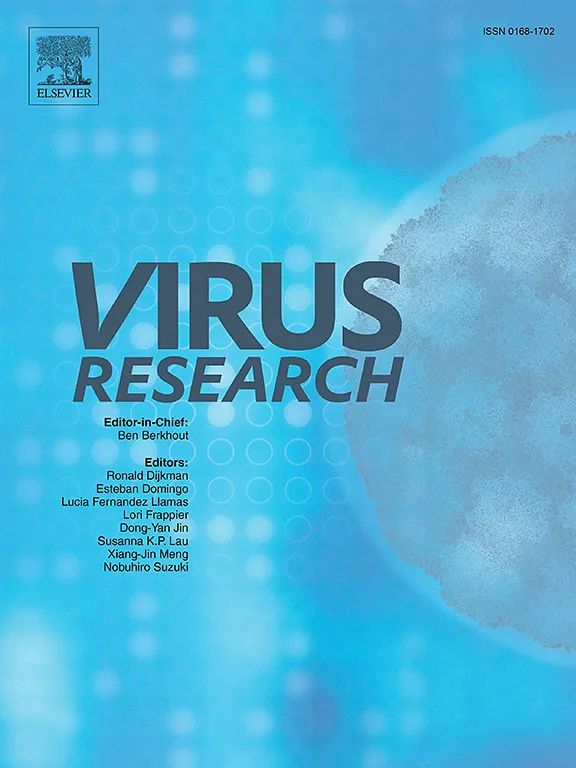Regional dynamics and mechanisms behind SARS-CoV-2 XDV.1 prevalence in Chongqing via genomic surveillance and molecular insights
IF 2.5
4区 医学
Q3 VIROLOGY
引用次数: 0
Abstract
The evolution of SARS-CoV-2 has led to the emergence of numerous variants driven by genetic mutations and evolutionary pressures, posing significant challenges to public health. Understanding the molecular mechanisms and epidemiological advantages of variants like XDV.1 remains incomplete. This study analyzed SARS-CoV-2 samples collected in Chongqing from January to August 2024 through genomic surveillance and molecular dynamics simulations. Whole-genome sequencing identified dominant variants, and all-atom simulations assessed the effects of key mutations in the receptor-binding domain (RBD) on ACE2 receptor interactions, including changes in binding free energy. Genomic analysis identified XDV.1 as the dominant variant, characterized by RBD mutations L455S and F456L. These mutations disrupted conserved hydrophobic interactions and caused structural rearrangements. Simulations revealed that these changes increased binding free energy (ΔG = -4.57 kcal/mol) but reduced binding affinity compared to BA.2.86 and JN.1. XDV.1 exhibits structural features suggestive of potential immune evasion mechanisms, including conformational shifts and novel hydrogen-bond networks that could interfere with antibody recognition. These observed structural modifications, rather than increased receptor-binding affinity, may contribute to its widespread prevalence, though direct experimental validation of antibody interactions remains to be investigated. These findings offer valuable insights for vaccine development and epidemiological studies, highlighting the importance of interactions between structural and non-structural proteins in variant adaptation.
基于基因组监测和分子分析的重庆市SARS-CoV-2 xdv - 1流行的区域动态和机制
SARS-CoV-2的演变导致在基因突变和进化压力的驱动下出现了许多变体,对公共卫生构成了重大挑战。对xdv - 1等变异的分子机制和流行病学优势的了解仍然不完整。本研究通过基因组监测和分子动力学模拟分析了2024年1月至8月在重庆采集的SARS-CoV-2样本。全基因组测序鉴定了显性变异,全原子模拟评估了受体结合域(RBD)关键突变对ACE2受体相互作用的影响,包括结合自由能的变化。基因组分析确定XDV.1为优势变异体,特征为RBD突变L455S和F456L。这些突变破坏了保守的疏水相互作用并引起结构重排。模拟结果表明,与BA.2.86和JN.1相比,这些变化增加了结合自由能(ΔG = -4.57 kcal/mol),但降低了结合亲和力。xdv - 1的结构特征暗示了潜在的免疫逃避机制,包括构象转移和可能干扰抗体识别的新型氢键网络。这些观察到的结构修饰,而不是增加的受体结合亲和力,可能有助于其广泛流行,尽管抗体相互作用的直接实验验证仍有待研究。这些发现为疫苗开发和流行病学研究提供了有价值的见解,突出了结构蛋白和非结构蛋白在变异适应中的相互作用的重要性。
本文章由计算机程序翻译,如有差异,请以英文原文为准。
求助全文
约1分钟内获得全文
求助全文
来源期刊

Virus research
医学-病毒学
CiteScore
9.50
自引率
2.00%
发文量
239
审稿时长
43 days
期刊介绍:
Virus Research provides a means of fast publication for original papers on fundamental research in virology. Contributions on new developments concerning virus structure, replication, pathogenesis and evolution are encouraged. These include reports describing virus morphology, the function and antigenic analysis of virus structural components, virus genome structure and expression, analysis on virus replication processes, virus evolution in connection with antiviral interventions, effects of viruses on their host cells, particularly on the immune system, and the pathogenesis of virus infections, including oncogene activation and transduction.
 求助内容:
求助内容: 应助结果提醒方式:
应助结果提醒方式:


